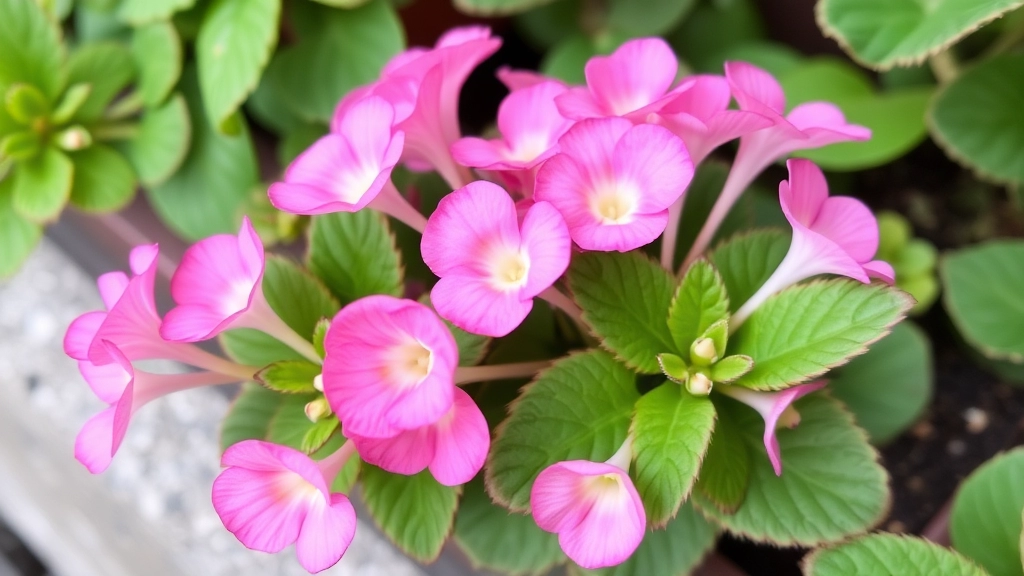Kalanchoe Pink Edges: A Captivating Succulent
When it comes to succulents, few varieties captivate like the Kalanchoe Pink Edges. Known for their vibrant pink hues that beautifully contrast with lush green leaves, these plants are a favourite among gardening enthusiasts. Whether you’re drawn to the striking Kalanchoe ‘Pink Butterflies’ or other pink-edged varieties, these unique succulents can add a pop of colour to any indoor or outdoor space.
Caring for Kalanchoe Pink Edges
Caring for Kalanchoe Pink Edges is straightforward but requires some specific attention to detail. These plants thrive in bright, indirect sunlight and need well-draining soil to prevent root rot. Watering should be done sparingly, allowing the soil to dry out completely between sessions. With the right care, your Kalanchoe can flourish and become a stunning focal point in your garden or home.
Top Varieties of Kalanchoe with Pink Edges
When it comes to Kalanchoe, the allure of pink-edged varieties is hard to resist.
Many plant enthusiasts find themselves captivated by the vibrant colours and unique leaf structures.
Here are some of the top varieties that stand out:
1. Kalanchoe âPink Butterflies’
- Known for its striking pink edges and rounded leaves.
- This variety produces small, delicate flowers that complement its foliage beautifully.
2. Kalanchoe âFlapjack’
- Features large, flat leaves with a stunning pink margin.
- Ideal for both indoor and outdoor settings, adding a pop of colour to any space.
3. Kalanchoe âCopper Spoons’
- Characterised by its spoon-shaped leaves with a lovely pink hue at the edges.
- A compact variety that fits perfectly on a windowsill or desk.
4. Kalanchoe âPink Chandelier’
- Displays a unique growth habit with cascading leaves.
- The pink edges make it a standout choice for hanging baskets.
5. Kalanchoe âMother of Thousands’
- While primarily known for its prolific offshoots, the pink-edged variety offers a delightful twist.
- Its leaves are adorned with charming pink borders that add visual interest.
These varieties not only provide aesthetic appeal but also bring unique characteristics to your plant collection. For more details on caring for these beautiful plants, check out our complete guide to growing and caring for Kalanchoe Pink Butterflies. Additionally, if you’re interested in learning about propagation techniques, you might find our guide on propagating Kalanchoe Mother of Thousands helpful.
How to Care for Kalanchoe ‘Pink Butterflies’
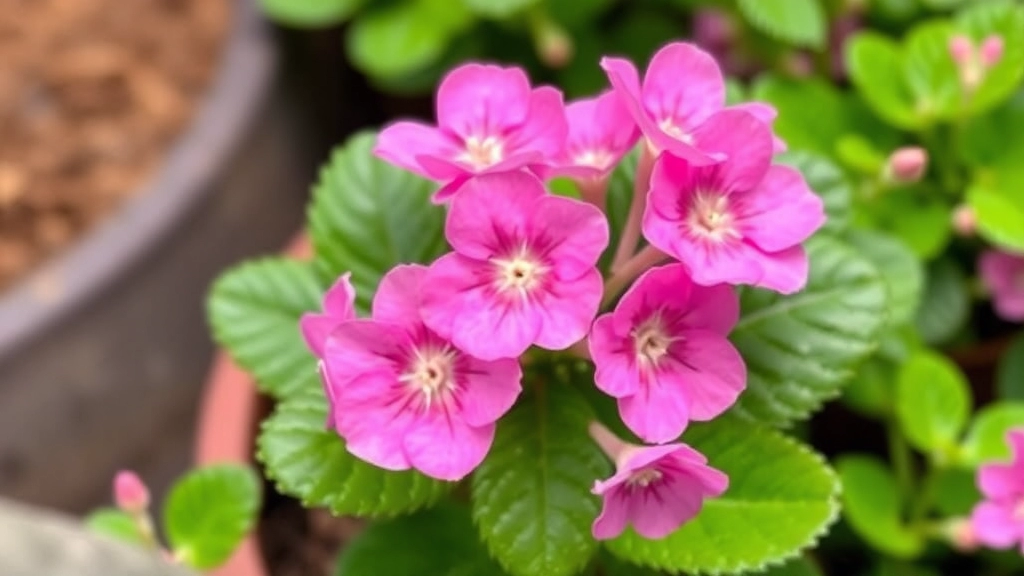
So, you’ve got a beautiful Kalanchoe ‘Pink Butterflies’ in your home, and you want to keep it thriving.
Let’s dive into some straightforward care tips that’ll have your plant looking its best.
Light and Location
- Bright, Indirect Light: Kalanchoe loves light but avoid direct sun. It can scorch those lovely pink edges.
- Indoor Spot: A windowsill with filtered light is perfect. If you’re outdoors, a shaded patio works wonders.
Watering Wisely
- Drench and Dry: Water thoroughly, then let the soil dry out completely before the next drink.
- Frequency: Typically, every 2–3 weeks, but adjust based on your climate.
Feeding Your Plant
- Fertilise: Use a balanced, water-soluble fertiliser every month during the growing season.
- Dilution: Make sure to dilute it to half strength. Too much can harm your plant.
Temperature and Humidity
- Ideal Range: Keep it between 18°C to 24°C (65°F to 75°F).
- Low Humidity: Kalanchoe prefers dry air, so avoid overly humid environments.
Pruning and Maintenance
- Remove Dead Leaves: Snip off any yellow or wilted leaves to keep it healthy.
- Encourage Growth: Pinch back the tips to promote bushier growth.
Pests and Diseases
- Watch for Pests: Keep an eye out for mealybugs and aphids. If you see any, treat with insecticidal soap.
- Check for Rot: Root rot can be a problem if overwatered. Always ensure proper drainage.
Understanding the sunlight and watering needs of your pink-edged Kalanchoe will set the foundation for its health and beauty. For more detailed care instructions, check out our [complete guide to growing and caring for Kalanchoe Pink Butterflies](https://planthq.org/complete-guide-to-growing-and-caring-for-kalanchoe-pink-butterflies/). Additionally, if you’re interested in other varieties, our [top Kalanchoe succulent varieties and care tips](https://planthq.org/top-kalanchoe-succulent-varieties-and-care-tips/) might be helpful.
Common Problems and Solutions for Kalanchoe Varieties
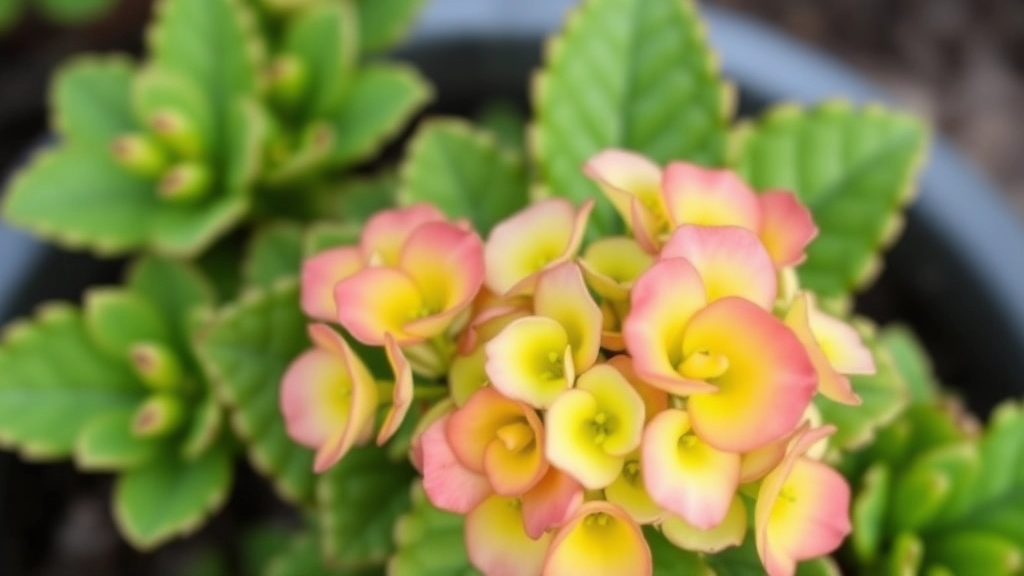
When caring for Kalanchoe varieties, you might encounter a few common challenges. Understanding these issues can help you keep your plants thriving.
1. Overwatering
One of the most frequent problems with Kalanchoe is overwatering. This succulent prefers dry conditions. Signs of overwatering include:
- Yellowing leaves
- Soft, mushy stems
- A foul smell from the soil
Solution:
- Allow the soil to dry out completely between waterings.
- Ensure your pot has proper drainage holes.
- If overwatering has occurred, consider repotting in fresh, dry soil.
2. Underwatering
Conversely, underwatering can also pose a problem. Kalanchoe may show signs of stress, such as:
- Droopy leaves
- Wrinkled or shrivelled appearance
- Leaf drop
Solution:
- Water your Kalanchoe thoroughly, allowing excess water to drain.
- Establish a regular watering schedule, typically every two weeks.
3. Pests
Kalanchoe can attract pests like aphids and mealybugs. You might notice:
- Sticky residue on leaves
- Cotton-like clusters on stems
- Distorted growth
Solution:
- Regularly inspect your plants for pests.
- Use insecticidal soap or neem oil to treat infestations.
- Keep your plants clean by gently wiping the leaves with a damp cloth.
4. Fading Colour
If the vibrant pink edges of your Kalanchoe are fading, it may be a sign of insufficient light. Look for:
- Pale or washed-out leaves
- Stretched stems
Solution:
- Move your plant to a brighter location, ideally near a south-facing window.
- Consider using grow lights if natural light is limited.
5. Flower Drop
Kalanchoe may drop flowers prematurely due to stress factors such as temperature fluctuations or inadequate light. Watch for:
- Dropping buds before they bloom
- Wilting flowers
Solution:
- Maintain a stable temperature, ideally between 15°C and 24°C.
- Ensure your plant receives adequate light during its blooming period.
Best Soil Mix and Potting Tips for Kalanchoe
When caring for Kalanchoe, especially those with stunning pink edges, the right soil mix is crucial for their health and vitality. You might be wondering, “What type of soil should I use for my Kalanchoe?”
Soil Mix Essentials
Kalanchoe plants thrive in well-draining soil. Here’s what you should consider:
- Cactus or Succulent Mix: This type of soil is specifically designed to promote drainage, which is vital for Kalanchoe.
- Perlite or Pumice: Adding these materials can enhance aeration and drainage. Aim for a mix of about 50% potting soil and 50% perlite.
- pH Level: Kalanchoe prefers slightly acidic to neutral soil, ideally between 6.0 to 7.0.
Potting Tips
Choosing the right pot is just as important as the soil. Here’s how to pot your Kalanchoe effectively:
- Drainage Holes: Always select pots with drainage holes to prevent waterlogging.
- Size Matters: Choose a pot that is slightly larger than the root ball; this allows for growth without excess soil that retains moisture.
- Repotting: Consider repotting every couple of years to refresh the soil and provide more space for growth.
Using the right soil mix and potting techniques not only supports the health of your Kalanchoe but also encourages vibrant blooming. For more detailed care tips, you might find our Ultimate Guide to Caring for Kalanchoe Succulents helpful. Additionally, if you’re growing varieties like the Pink Butterflies, check out our Care Tips for Kalanchoe Pink Butterflies.
Propagating Pink-Edged Kalanchoe Succulents
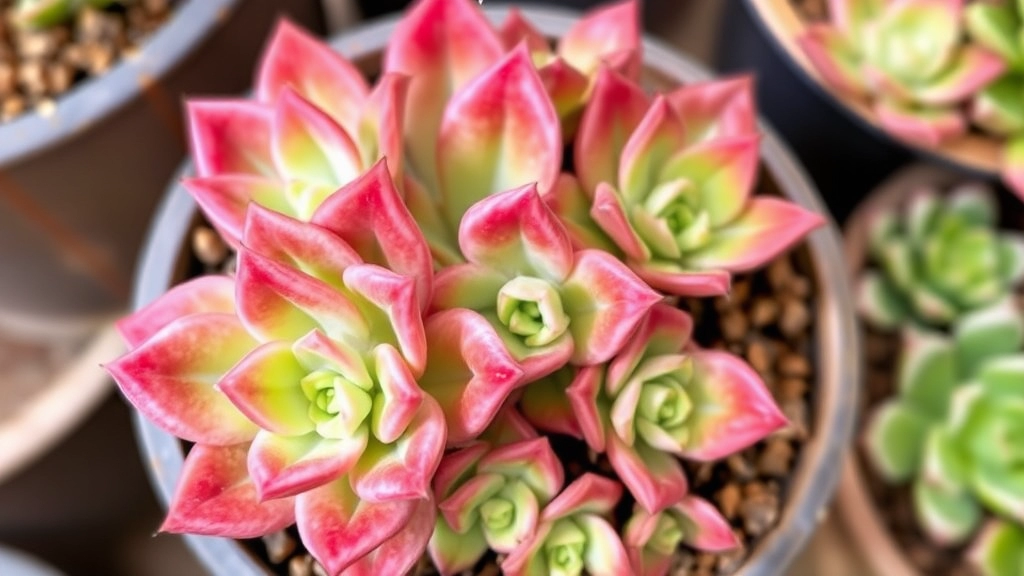
So, you’re keen to multiply your stunning pink-edged Kalanchoe? You’re in the right place! Propagating these beauties is easier than you might think, and it’s a fantastic way to share the love with friends or expand your personal collection.
Why Propagate?
- Cost-Effective: Save money by growing more plants from a single one.
- Personal Touch: Each new plant carries a bit of your gardening journey.
- Fun Activity: It’s rewarding to see your efforts blossom into new life.
Methods of Propagation
- Leaf Cuttings:
- Choose a healthy leaf from your Kalanchoe.
- Cut it cleanly at the base.
- Let it dry for a day or two to form a callous.
- Place it in well-draining soil and water lightly.
- Stem Cuttings:
- Snip a healthy stem about 4-6 inches long.
- Remove the lower leaves to expose the nodes.
- Allow it to dry for a day.
- Plant it in soil, ensuring the nodes are buried.
- Offsets:
- Some Kalanchoe varieties produce offsets or “pups.”
- Gently separate the pups from the main plant.
- Replant them in their own pots.
Tips for Successful Propagation
- Timing: Spring is the best time to propagate, as the plant is in its growth phase.
- Humidity: Keep the cuttings in a humid environment, but avoid direct sunlight.
- Patience: It may take a few weeks for roots to develop, so don’t rush it.
Common Mistakes to Avoid
- Overwatering: Ensure the soil dries out between waterings.
- Lack of Light: Place your cuttings in a bright, indirect light spot.
- Ignoring Temperature: Keep them in a warm environment, ideally around 20-25°C.
Where to Buy Rare Pink Kalanchoe Plants
Finding rare pink Kalanchoe plants can feel like a treasure hunt, especially when you’re eager to add a unique touch to your collection.
Growing Kalanchoe Indoors vs Outdoors
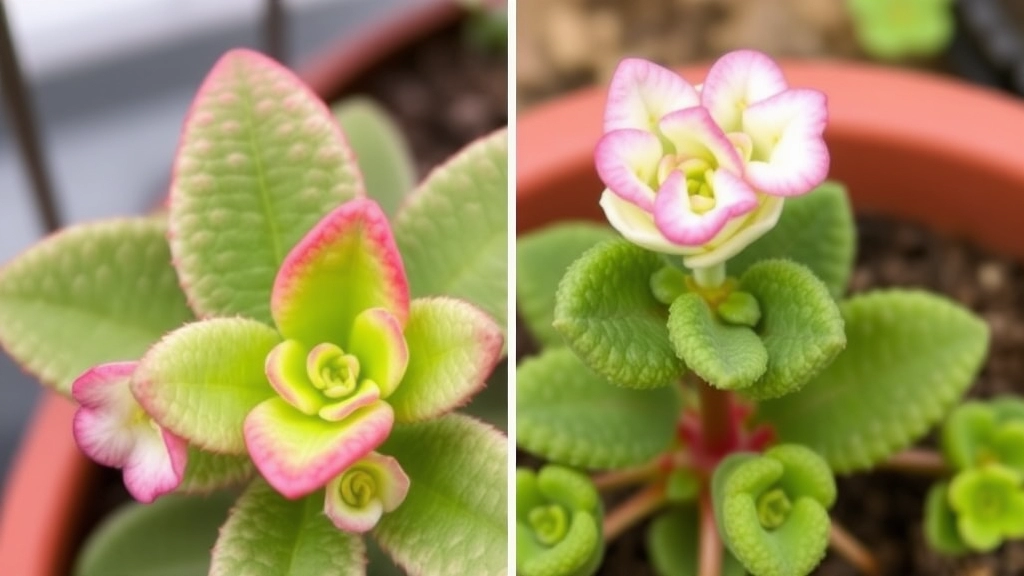
So, you’re thinking about where to grow your stunning Kalanchoe with those lovely pink edges?
It’s a common dilemma for plant lovers.
Growing Indoors
Growing Kalanchoe indoors can be a fantastic option.
Here’s why:
- Controlled Environment: You can manage temperature and humidity easily.
- Less Exposure to Pests: Indoor plants are often less prone to pests and diseases.
- Decorative Touch: They add a splash of colour to your home décor.
However, keep these tips in mind:
- Light: Place them near a bright window. They love that sunshine!
- Watering: Be careful not to overwater. Indoor plants often need less than you think.
- Potting: Use pots with drainage holes to prevent root rot.
Growing Outdoors
If you have the space, growing Kalanchoe outdoors can be equally rewarding.
Here’s what you need to know:
- Natural Light: They thrive in full sun, so a sunny spot is ideal.
- Air Circulation: Outdoor plants often benefit from better airflow, reducing the risk of mould.
- Larger Growth: They can grow larger and bloom more vibrantly outside.
But don’t forget:
- Temperature: Make sure the weather is suitable. Kalanchoe prefers warm conditions.
- Watering: Outdoor plants might need more water, especially during hot spells.
- Protection: Shield them from harsh winds or heavy rain.
Seasonal Flowering Patterns of Pink Kalanchoe
Understanding the seasonal flowering patterns of Pink Kalanchoe can help you anticipate when to expect those stunning blooms.
Many enthusiasts wonder why their Kalanchoe doesn’t flower consistently or what triggers the blooming process.
Flowering Timing
- Winter to Spring: Pink Kalanchoe typically flowers from late winter to early spring.
- Light Influence: The amount of daylight plays a crucial role in triggering blooms.
- Day Length: They require shorter days (around 12 hours of light) to initiate flowering.
Factors Affecting Blooming
- Temperature: Ideal temperatures range from 15°C to 25°C.
- Watering: Overwatering can lead to root rot, preventing flowering.
Encouraging Blooms
- Pruning: After flowering, prune back spent blooms to encourage new growth.
- Fertilisation: Use a balanced fertiliser during the growing season to promote healthy blooms.
Related Care Guides
For more detailed information on how to care for your Kalanchoe, check out our guide on caring for Pink Butterflies Kalanchoe and our tips for healthy growth of Pink Kalanchoe.
FAQs on Kalanchoe ‘Pink Butterflies’ Care and Propagation
What kind of light does Kalanchoe ‘Pink Butterflies’ need?
Bright, indirect light is ideal for Kalanchoe ‘Pink Butterflies’. Avoid direct sunlight as it can scorch the pink edges.
How often should I water my Kalanchoe ‘Pink Butterflies’?
Water thoroughly and then let the soil dry out completely before the next watering. Typically, this means watering every 2–3 weeks, but adjust based on your local climate conditions.
What type of fertilizer should I use for my Kalanchoe?
Use a balanced, water-soluble fertilizer diluted to half strength. Fertilize monthly during the growing season.
What is the ideal temperature range for Kalanchoe ‘Pink Butterflies’?
The ideal temperature range is between 18°C to 24°C (65°F to 75°F). Kalanchoe prefers dry air, so avoid overly humid environments.
How can I prevent pests and diseases in my Kalanchoe?
Regularly inspect your plant for pests like mealybugs and aphids. Use insecticidal soap if necessary. Ensure proper drainage to avoid root rot.
What are common signs of overwatering my Kalanchoe?
Signs of overwatering include yellowing leaves, soft, mushy stems, and a foul smell from the soil. Allow the soil to dry out completely between waterings and ensure proper drainage.
How do I propagate Kalanchoe ‘Pink Butterflies’?
You can propagate Kalanchoe through leaf cuttings, stem cuttings, or offsets. Allow cuttings to dry and form a callous before planting in well-draining soil.
What should I do if the pink edges of my Kalanchoe are fading?
If the pink edges are fading, it may be a sign of insufficient light. Move your plant to a brighter location, ideally near a south-facing window, or consider using grow lights.
Can I grow Kalanchoe ‘Pink Butterflies’ indoors?
Yes, growing Kalanchoe indoors is a great option. Ensure it receives bright, indirect light, and be cautious with watering. Use pots with drainage holes to prevent root rot.
What are the benefits of growing Kalanchoe outdoors?
Outdoors, Kalanchoe can thrive in full sun and benefit from better air circulation, which reduces the risk of mold. They can also grow larger and bloom more vibrantly.
What should I do if my Kalanchoe drops its flowers prematurely?
Flower drop can be due to stress factors like temperature fluctuations or inadequate light. Maintain a stable temperature between 15°C and 24°C and ensure the plant receives adequate light during its blooming period.
References
-
Growing Kalanchoe Indoors – Gardening Know How
-
How to Grow Kalanchoe Indoors – The Spruce
-
Kalanchoe Plant Care – Better Homes & Gardens
